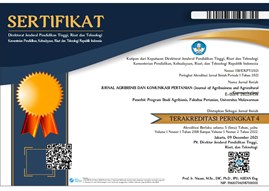FAKTOR-FAKTOR YANG MEMPENGARUHI KEGIATAN PEMELIHARAAN TANAMAN SALAK PONDOH (Salacca zalaca) DI DESA KARANG JINAWI KECAMATAN SEPAKUKABUPATEN PENAJAM PASER UTARA (Factors affecting the cultivation of salak pondoh (Salacca Zalaca) at the Karang Jinawi village, Sepaku district, Penajam Paser Utara district)
Abstract
The research on factors that affecting the cultivation of salak pondoh (Salacca Zalaca) in order to increase the production of salak pondoh, it was found that intensive cultivation is needed. Salak cultivation includes fertilization, irrigation, weeding, pruning of salak plants, use of insect pollinators, human-assisted pollination, fruit care, pest control and deseases.
Therefore the purpose of this research was to determine the cultivation activities of salak and factors that affected farmers in cultivation salak pondoh (salacca zalaca) plants in the village of Karang Jinawi, Sepaku district, Penajam Paser Utara district.
In this reasearch, the data obtained are primary and secondary data. Where primary data is obtained through direct interviews with respondents, as many as 27 respondents. While for secondary data obtained from the Mulawarman University library and Faculty of Agriculture, Karang Jinawi village office, center of statistic institutions and agricultural technical service unit in sepaku district. And the measurement variable used in this research is land area, education, fertilizer, cultivation activities.
This research using data analysis method called Cobbdouglas function which is transformed into a logarithmic form to obtain a multiple linear regression equation. From the reasearch results showed that the land area had a positive and significant effect on the cultivation of salak pondoh plants, with a significant value is 0.000 and a regression coefficient is 0.106. And for the variable length of education did not have a significant effect on the production of salak pondoh. Whereas the variable amount of fertilizer application has a positive and significant effect on the production of salak pondoh.Keywords
Full Text:
PDFReferences
Ahmadi dan Uhbiyati. 2007. Ilmu Pendidikan. Rineka Cipta, Jakarta.
Anonim. 2010. Pedoman Budidaya Salak. Nuansa Aulia, Bandung.
Cahyono, B. 2016. Panen Untung dari Budidaya Salak Intensif. Andi, Yogyakarta.
Nixon, M.T. 2009. Buku Pintar Budidaya Tanaman Buah Unggul Indonesia. Agromedia Pustaka, Jakarta.
Putra, I.G. 2011. Pengelolaan Hara Kalium Berdasarkan Batas Kritis untuk Tanaman Jagung (Zea mays L.) pada Berbagai Status Hara di Tanah Inceptisol. Tinjauan Pustaka..
Diakses pada 15 September 2018.
Rahim. 2007. Ekonomi Pertanian (Pengantar Teori dan Kasus). Penebar Swadaya, Jakarta.
Santoso, H.B. 2006. Salak Pondoh. Kanisius. Yogyakarta.
Sudjana. 2002. Metode Statistika. Tarsito. Bandung.
Sugiyono. 2012. Metode Penelitian Kuantitatif dan Kualitatif dan R&D. Alfabeta, Bandung.
Tama, Y, F., Jumantri, dan 2014. Analisis Usaha Tani dan Pemasaran Salak pondoh (Salacca Edulis Reinw) di Desa Rambah Baru Kecamatan Rambah Samo Kabupaten Rokan Hulu. Jurusan Agribisnis Fakultas Pertanian Universitas Riau, Riau.
Tim Karya Mandiri. 2010. Pedoman Budidaya Buah Salak. Nuansa Aulia, Bandung.
DOI: http://dx.doi.org/10.35941/jakp.5.1.2022.7060.33-41
Refbacks
- There are currently no refbacks.
Copyright (c) 2022 JURNAL AGRIBISNIS DAN KOMUNIKASI PERTANIAN (Journal of Agribusiness and Agricultural Communication)

This work is licensed under a Creative Commons Attribution-ShareAlike 4.0 International License.
Program Studi Agribisnis, Fakultas Pertanian, Universitas Mulawarman.
Study Program of Agribusiness, Faculty of Agriculture, University of Mulawarman.
Jl. Pasir Balengkong Kampus Gunung Kelua. Kota Samarinda, Provinsi Kalimantan Timur, Indonesia. 75123.
E-mail: jurnal_akp@faperta.unmul.ac.id
_____________________________________________________________________________________________________________________________________________________
![]()

Journal of Agribusiness and Agricultural Communication by http://e-journals.unmul.ac.id/index.php/AKP/ P-ISSN 2622-5050, E-ISSN 2622-6456 is licensed under a Creative Commons Attribution-ShareAlike 4.0 International
We are endorsed by CORIS (Cooperation Research Inter University) and are listed as one of their association journals. Our journal in CORIS: link.

This work is licensed under a Creative Commons Attribution-NonCommercial 4.0 International License.





.png)




